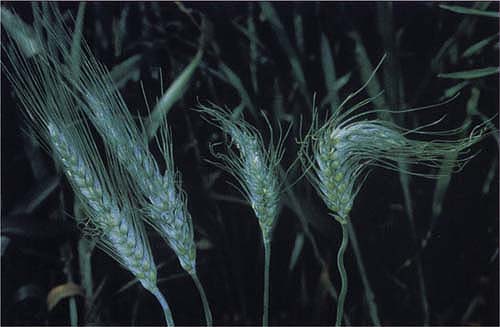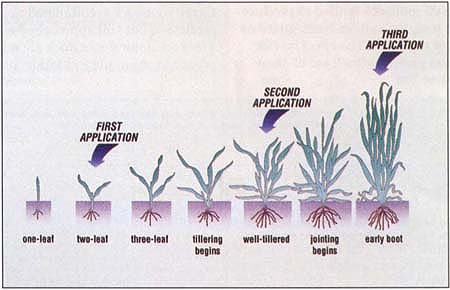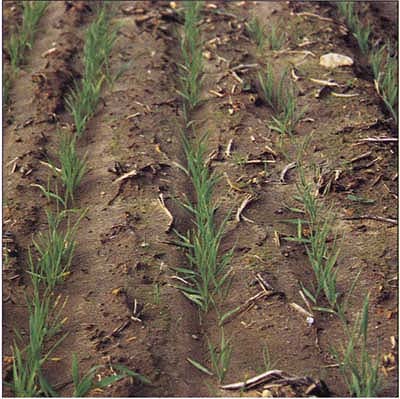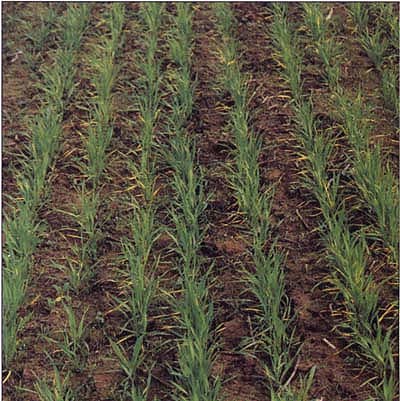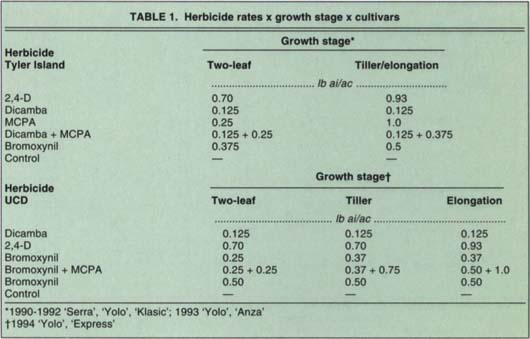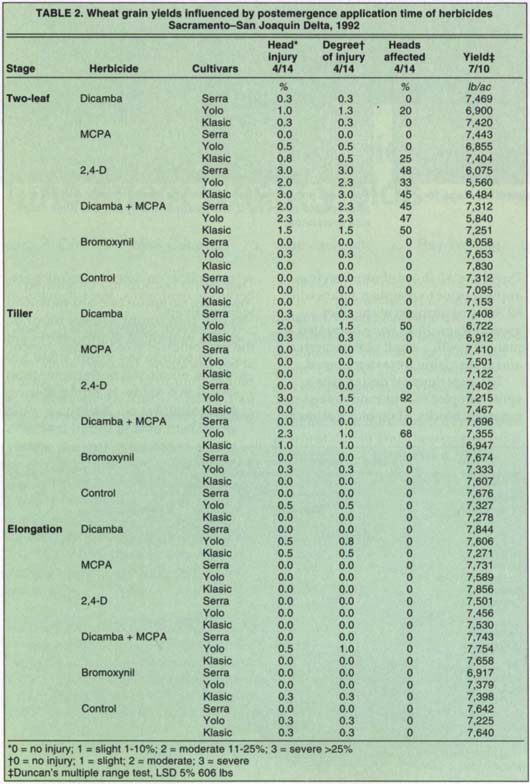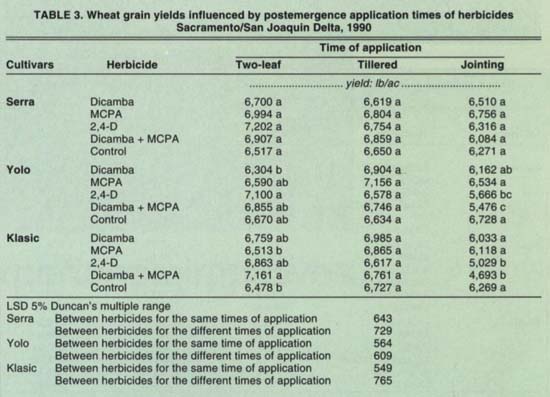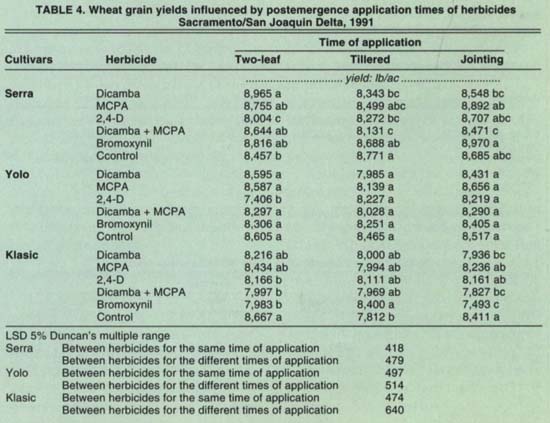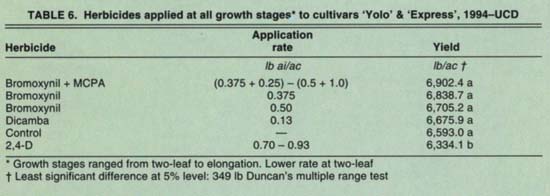All Issues
Postemergence herbicides and application time affect wheat yields
Publication Information
California Agriculture 50(4):32-36. https://doi.org/10.3733/ca.v050n04p32
Published July 01, 1996
Abstract
Experiments conducted on wheat grown in the Sacramento and San Joaquin valleys found that two of the most critical factors in reducing plant injury are choice of postemergence herbicide and the growth stage at which the herbicide is applied. To minimize risk of wheat injury and to maximize yields, the optima! time to apply postemergence herbicides is at the tillering growth stage. The two-leaf stage is most sensitive to 2,4-D. Moderate or severe injury caused by 2,4-D and dicamba + MCPA on one-third to one-half of spikes can cause yield losses of up to 27%.
Full text
Wheat is an important crop in California, grown on more than 500,000 acres in the Sacramento and San Joaquin valleys. Predominant cultivars in the Sacramento Valley are ‘Yolo’, ‘Anza’ and ‘Express’, while ‘Yecora Rojo’ is the main cultivar in the San Joaquin Valley. In past years, various fields have shown injury from postemergence applications of the phenoxy and benzoic herbicides, 2,4-D and dicamba, respectively, as well as MCPA combined dicamba. Grain heads and awns (beards) show various degrees of malformation, or epinasty, ranging from slight to severe. The cause of injury and its effect on grain yields are unclear.
In the past, the amount of yield loss in wheat due to grain head injury from postemergence herbicides has been very difficult to estimate. Symptoms of herbicide injury in commercial fields varied from slight to severe; however, prior to this study, the relationship between visual injury symptoms and yield had not been made.
We investigated the effects of several postemergence herbicides on grain injury and yields. Our research included rate of application and liming (by wheat stage of growth) of herbicide applications to various cultivars. We studied five different wheat cultivars to determine interactions between different herbicides and cultivars at various growth stages. Experiments were conducted from 1990 to 1993 on the Lewellen Ranch on Tyler Island in the Sacramento-San Joaquin Delta, and at the UC Davis Agronomy Farm from 1993 to 1994.
For least amount of risk of damage, the tiller stage is the most appropriate stage for 2, 4-D treatment. Beyond the tiller stage, risk increases.
Application stages
Hard red spring cultivars ‘Serra’, ‘Yolo’, ‘Anza’ and ‘Express’, and a hard white, ‘Klasic’, were planted with a grain drill in the fall of 1989, 1990 and 1991. ‘Yolo’ and ‘Anza’ were planted in 1992, and ‘Yolo’ and ‘Express’ in 1993. The wheat was grown under winter rainfall, supplemented by irrigation in the spring. The Tyler Island site was on an Egbert muck soil with spud ditches for irrigation; the UC Davis site, located on a Yolo fine sandy loam, was furrow irrigated. Starter fertilizer 11–52–0 was applied under the seed at both sites at a rate of 80 Ib/ac. The Tyler Island site had a top dressing of 25 lb/ac of nitrogen as urea at tiller growth stage. At the UC Davis site, 80 lb/ac of nitrogen was applied prior to planting, followed by 62 lb/ac of nitrogen at the tiller growth stage. Plots were harvested at maturity with a small plot harvester and grain yields were determined.
The experimental design was a split-split plot in four randomized complete blocks. Main plot treatments were application times. Subplots were herbicide treatments, and sub-subplots were cultivars.
Chickweed, Stellaria media (L.), was the predominant weed species present at both locations. The population ranged from 10 to 30 plants per square foot. Miner's lettuce, Montia perfoliate, was also present at the UC Davis site with a population of 17 plants per square foot.
Herbicides were applied at various wheat growth stages using a C02 backpack sprayer, 8002 E flat fan nozzles, at a rate of 15 gallons of water per acre. The applications were made at three growth stages: two-leaf, fully tillered and the internode elongation stage between jointing and early boot (fig. 1). The lowest labeled herbicide rates (table 1) were used at the first wheat growth stages, when weeds were smallest, and increased to maximum label rates at the tillering and elongation stages when weeds were larger. Herbicide treatments consisted of 2, 4-D-amine, dicamba, dicamba + MCPA, MCPA alone, and bromoxynil. Bromoxynil was not in the 1990 study, but replaced dicamba + MCPA in the 1993–1994 study. A higher rate of bromoxynil also replaced the MCPA treatment in the 1993–1994 study to determine if these new treatments were more effective in reducing injury while still providing weed control. Visual ratings were made on a scale of 0 to 10 of chickweed and miner's lettuce control throughout the season. The three measurements made to determine extent of injury to grain heads were: 1) percent of total heads affected, 2) degree of injury to wheat spikes on a scale of 0 to 3 (severe), and 3) percentage of the head affected.
TABLE 2. Wheat grain yields influenced by postemergence application time of herbicides Sacramento-San Joaquin Delta, 1992
Injury by growth stages, 1992
In 1992 the herbicide treatment dicamba + MCPA applied at the two-leaf stage caused significant visual injury to the ‘Serra’, ‘Klasic’ and ‘Yolo’ cultivars. ‘Klasic’ was the least affected, with slight damage to 50% of the heads. ‘Serra’ and ‘Yolo’ showed moderate injury to 45% of heads. ‘Yolo’ was the only cultivar whose yield was reduced significantly, dropping from 7,095 Ib/ac in the control to 5,840 lb/ac in the treated plot.
The 2,4-D treatment also resulted in significant visual injury to the wheat. ‘Serra’ and ‘Klasic’ had severe injury to 45% of heads, while ‘Yolo’ showed moderate injury across 33% of heads. Again, ‘Yolo’ yields were most affected with a 22% reduction, compared with 17% reduction for ‘Serra’ and 9.4% for ‘Klasic’ (table 2).
Dicamba caused slight injury only to ‘Yolo’ with 20% of the plants showing epinasty in the spikelets. However, there was no significant reduction in yield compared to the control.
At the tiller application stage, ‘Yolo’ was the only cultivar to show significant injury from dicamba, 2,4-D and dicamba + MCPA, with 92% of plants damaged by 2, 4-D, 68% by dicamba + MCPA and 50% by dicamba. Degree of injury was slight for all three herbicides; yield was significantly reduced by dicamba when compared to MCPA. There was no significant difference between dicamba and the other treatments (table 2).
Herbicides applied at the elongation stage did not result in any significant symptoms for the three cultivars. However, ‘Serra’ yield was significantly reduced from bromoxynil at 0.5 lb ai/ac(table 2).
Results by year
In 1990, herbicide treatments 2,4-D and dicamba + MCPA were especially injurious to wheat when applied at the jointing growth stage. ‘Yolo’ yields were most affected, with a decrease of 1,062 lb /ac with 2,4-D, and 1,252 lb/ac with dicamba + MCPA, when compared to the control. Yield for ‘Klasic’ was down 19% from 2,4-D and 25% from dicamba + MCPA. ‘Serra’ yields were not affected (table 3).
In 1991, 2,4-D application at the two-leaf stage caused significant yield reduction to ‘Serra’ and ‘Yolo’. Dicamba caused a 10.7% decrease in ‘Serra’ and 12.7% decrease for ‘Yolo’. Overall, ‘Yolo’ was least affected by herbicides applied at any growth stage (table 4).
In 1992, 2,4-D application at the two-leaf stage was the most damaging to all three cultivars. Yields were significantly reduced for ‘Serra’, ‘Yolo’ and ‘Klasic’. Application of dicamba + MCPA resulted in significant yield reduction for ‘Yolo’ at this stage (table 5).
In 1993, herbicides applied to ‘Yolo’ and ‘Anza’ at all three growth stages did not cause injury or significant differences in yield.
In 1994, the cultivars ‘Yolo’ and ‘Express’ were used, and herbicide treatments changed slightly. Bromoxynil + MCPA replaced dicamba + MCPA, and a higher rate of bromoxynil replaced the MCPA treatment. No significant interactions were detected between herbicide treatments, cultivars or growth stages. However, 2,4-D applications on cultivars at all growth stages resulted in a significant yield reduction — 6,334 lb/ac versus an average yield of 6,780 lb/ac for the other herbicide treatments (table 6).
Injury minimized at tillering stage
To minimize risk of wheat injury and maximize yields, the best time to apply postemergence herbicides is at the tillering growth stage.
Depending on the year and environmental conditions at the time of application, the two-leaf stage is the most sensitive time for applications of 2,4–D. However, judging from environmental data collected, there does not appear to be a single contributing factor (table 7). Results of 4 to 5 years of tests on ‘Yolo’ showed that 2,4-D applied at the two-leaf stage caused yield reductions of 20% (6,284 lb/ac compared with 7,158 lb/ac for untreated plants, and 7,097 lb/ac for plants treated with bromoxynil). Application of 2,4-D, dicamba + MCPA or bromoxynil at the jointing growth stage sometimes resulted in injury or yield reductions to ‘Serra’, ‘Yolo’ and ‘Klasic’ (tables 3, 4 and 5).
TABLE 3. Wheat grain yields influenced by postemergence application times of herbicides Sacramento/San Joaquin Delta, 1990
TABLE 4. Wheat grain yields Influenced by postemergence application times of herbicides Sacramento/San Joaquin Delta, 1991
Our research also found that growers do not have to treat wheat with an herbicide if chickweed or miner's lettuce are the primary weed species. In fact, there may be a risk of actually reducing yields, depending on the herbicide used and the growth stage of the wheat. In our experiments, grain yields for the nontreated controls were equal to or higher than grain yields for herbicide-treated wheat.
Proper timing of herbicide application to this Delta wheat field resulted in excellent grain heads and high yield.
TABLE 5. Wheat grain yields influenced by postemergence application times of herbicides Sacramento/San Joaquin Delta, 1992
There are significant differences in yield depending on which herbicide and at which growth stage the herbicide is applied. In regard to the Yolo cultivar, the amount of yield reduction depends on the degree of spike injury and the number of spikes affected. Slight injury covering a high percentage of spikes has little effect on yield, while moderate or severe injury to one-third to one-half of spikes caused by 2,4-D and dicamba + MCPA can cause yield losses of up to 27%. Choice of herbicide can make a considerable difference in yield outcome: the bromoxynil treatment to Yolo, for instance, yielded 7,653 lb/ac versus 5,560 lb/ac with 2,4-D.
Several steps can be taken to reduce injury to wheat by postemergence herbicides:
-
Use the appropriate herbicide for the weed species present.
-
Apply phenoxy or benzoic + phenoxy herbicide combinations at the tillering growth stage to minimize injury.
-
Use lower- to mid-range label rates when weeds are small and grain growth stage is less than full tiller.
-
Dicamba, bromoxynil, or bromoxynil + MCPA present less risk to wheat when applied at the early (two-leaf) growth stage compared to 2, 4-D or dicamba + MCPA.
Through a properly integrated weed management system, risk of injury is reduced and wheat yield increased.



